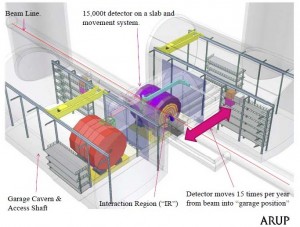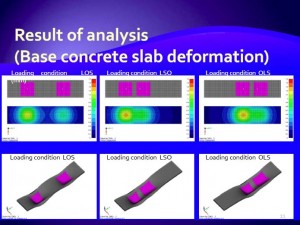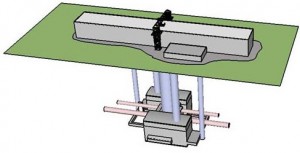
The push-pull concept as illustrated from the CERN ARUP report, considering the scheme for both CLIC and ILC
Since the inception of the ILC design effort, we have been developing the concepts for detectors to do the science as an integral part of our work. The interactions between the accelerator and the detectors are complex and demanding. For that reason, we have a group of accelerator and detector experts working together on machine-detector interface (MDI) issues. The ILC physics programme is based on building two complementary detectors that will share beam time. The value of having two detectors with different designs, technologies, collaborations and emphasis has proven to be a very effective way to exploit the science, as evidenced through three generations of colliders.
In the ILC Reference Design Report (RDR), chapter 8 of the detector volume very effectively outlines the arguments for having two detectors. To quote the introduction to that chapter: “The ILC’s scientific productivity will be optimised with two complementary detectors operated by independent international collaborations, time-sharing the luminosity. This will ensure the greatest yield of science, guarantee that discoveries can be confirmed and precision results can be cross-checked, provide the efficiency of operations, reliability, and insurance against mishap demanded for a project of this magnitude, and enable the broadest support and participation in the ILC’s scientific programme.” The arguments for planning for two detectors are further discussed in the chapter.
However, in carrying out the early design work, it soon became apparent that designing two independent beam lines that alternately share the beam would be an expensive proposition. The problem is that the beam delivery system for the ILC is in itself a long, complex and demanding system and therefore the cost of building two such systems was forbidding. As a result, in the RDR, we proposed using a push-pull concept to cost-effectively share the beam between two detectors. Previous detectors have been built such that they can be moved on and off the beamline for servicing and upgrades, but the demands were far less than for the ILC, where we want to be able to change between the detectors on relatively short time scales and with little down time. At the time of the RDR, we were able to determine that there appeared to be no show stoppers in this scheme for the RDR, but were not able to develop a design that could accommodate the differences between detectors and meet the other ambitious requirements.

A study of the concrete slab deformation under the detectors in the Japanese interaction region study
For the Technical Design Report, we undertook to carry out engineering designs, and for rather different sites. Now we have completed concepts to accommodate two detectors on a common platform, and have defined access and staging areas and to meet the other demanding technical requirements. It is also interesting that the Compact Linear Collider (CLIC) Study has adopted the push-pull system as well, with some specific differences to meet their more severe requirements for the stability of the final focus.
The CERN ARUP (a civil engineering consultant company) study concluded that the displacement limits of plus or minus 2 millimetres can be achieved by moving ILD on a 2.2-metre slab and SiD on a 3.8-metre slab, both with pads or rollers. They recommend future work on the movement system and an evaluation of the slab final positioning systems. Their study of the overall cavern performance under load in the CERN geology is somewhat marginal and depends on the detailed geology, in situ stresses and the construction sequence.
We are now reviewing the facility costs for the ILC push-pull designs, in order to ensure that we maintain the same cost consciousness for these facilities as we are for the rest of the ILC complex. Overall, however, we have established the reality of employing a push-pull system for ILC (and CLIC) and have identified the issues needing further study.



Second sentense in the fourth pargraph “Now we have completed concepts to accommodate two detectors on a common platform”, I think should state “Now we have completed concepts to accommodate two detectors on an individual platform”.